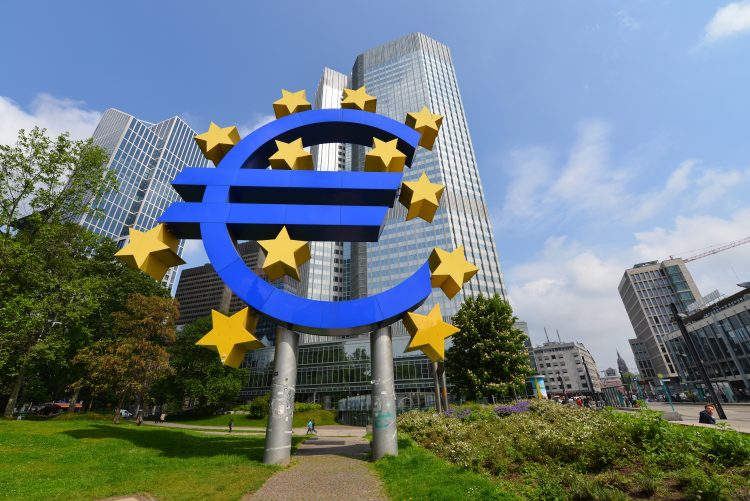Draghi’s Poisoned Price Signal
Every asset in the world is priced with reference to the bond market, at least in theory. The bond market dictates your risk-free (ok, low risk) opportunity cost. It’s the so-called price signal. Say you’re considering investing in equities or real estate or barrels of oil – these assets entail greater risk than a bond. So don’t bother unless you receive adequate excess return.

The same applies in the creation of new assets. Looking to build a block of flats on former farmland, expand a manufacturing facility or drill a hole in the earth seeking oil? Textbooks say that bond yields should play a part in your calculations.
So government and high quality corporate bond rates have long been important bellwethers. They are the most important price signals in all of finance. But thoroughly rigged is today’s bond market, especially in Europe.
European interest rate market is fixed
A recent email from Grant’s Interest Rate Observer to subscribers gave a timely reminder. It quoted the CEO of Deutsche Bank, John Cryan, from late 2016:
“The impact of buying up corporate bonds is that we see, in our bank, bond-trading volumes down something like three-quarters. And there has absolutely been no price discovery now in corporate bonds, so we don’t really know the price of credit, which is a dangerous situation”.
That quote is consistent with what I’ve heard. A friend of mine has been a bond salesman for the DACH region (Germany, Austria and Switzerland) for a few decades, tasked with talking to clients and facilitating bids and offers between them and the bank’s traders. He focuses on corporate offerings.
He told me the market has never been so dead, there’s nothing much to do. He’s out the door at 4:30 nearly every afternoon. There is still decent business in primary offers (when a corporate client wants to raise fresh money via a bond) but the secondary market is completely dead.
Why? Because the ECB bond buying program hoovers up everything offered in the secondary market. They’re also buying primary issues in some markets. The ‘tapering’ of that program from €80 million a month to €60 million from April 2017 has made no noticeable difference. They dominate the ‘bid’ and suppress volatility in the process.
Wisdom of the few
The price signal was once the by-product of thousands of individual players making self-interested decisions. There was wisdom in the crowd, if not at all times then at least over time. Today, those prices for the whole of Europe are set largely from inside one building in Frankfurt. What was once somewhat reliable is today as trustworthy as a fox in the hen pen. Completely distorted. By design.
Of course, this fact is well known. The aim of this post is to share a potentially useful anecdote and reminder rather than get into a long treatise on my subjective thoughts on the flaws in modern central banking. Your life is too short and worthwhile. But the market is rigged. And I can’t help but draw one of just a few possible conclusions:
1. Market participants are naïve. Central bankers decided that the risks from elevated prices for existing assets are outweighed by the knock on effect of companies and investors adding new capacity and demand, boosting the real economy in the process (ignore, for now, that this hasn’t gone to plan, new equipment and infrastructure investment still runs well below average). Taking cues from the old American saying ‘don’t fight the Fed’, investors are responding by buying lower quality assets than they otherwise would, at higher prices than they otherwise would have to pay, in order to earn returns no longer available in either government or corporate bond markets.
2. The ECB is naïve and filled with first order thinkers. It doesn’t realise the market is a complex, adaptive system where players are always trying to second-guess the intentions of other players. The ECB foot on top of the head of interest rates is obvious to all. Players are adequately adjusting for it when they think about risk-free rates in the pricing of riskier assets and creation of new assets.
3. A bit of both
Compressed high yield spreads and rising equity and real estate markets in Europe argue strongly for conclusion 1. The complete buyers’ strike in the bond market offers contrast, suggesting conclusion 2. My gut says go with 3.
Buy now, pay later
European investors do appear to be taking on riskier assets because of low bond rates. European first home buyers are buying increasingly richly-priced properties, often with floating rate mortgages. European companies may finally be making some expansion decision using suppressed bond rates in their cost of capital calculations. On some level, they are all being played like violins.
The long term consequences of this manipulation? Your guess is as good as mine. Those central planners, err economists, in Frankfurt clearly have more faith in their own judgement than I do. Somewhere between benign and damaging is my best guess.
If you are interested in receiving the here.
.jpg)
.jpg)